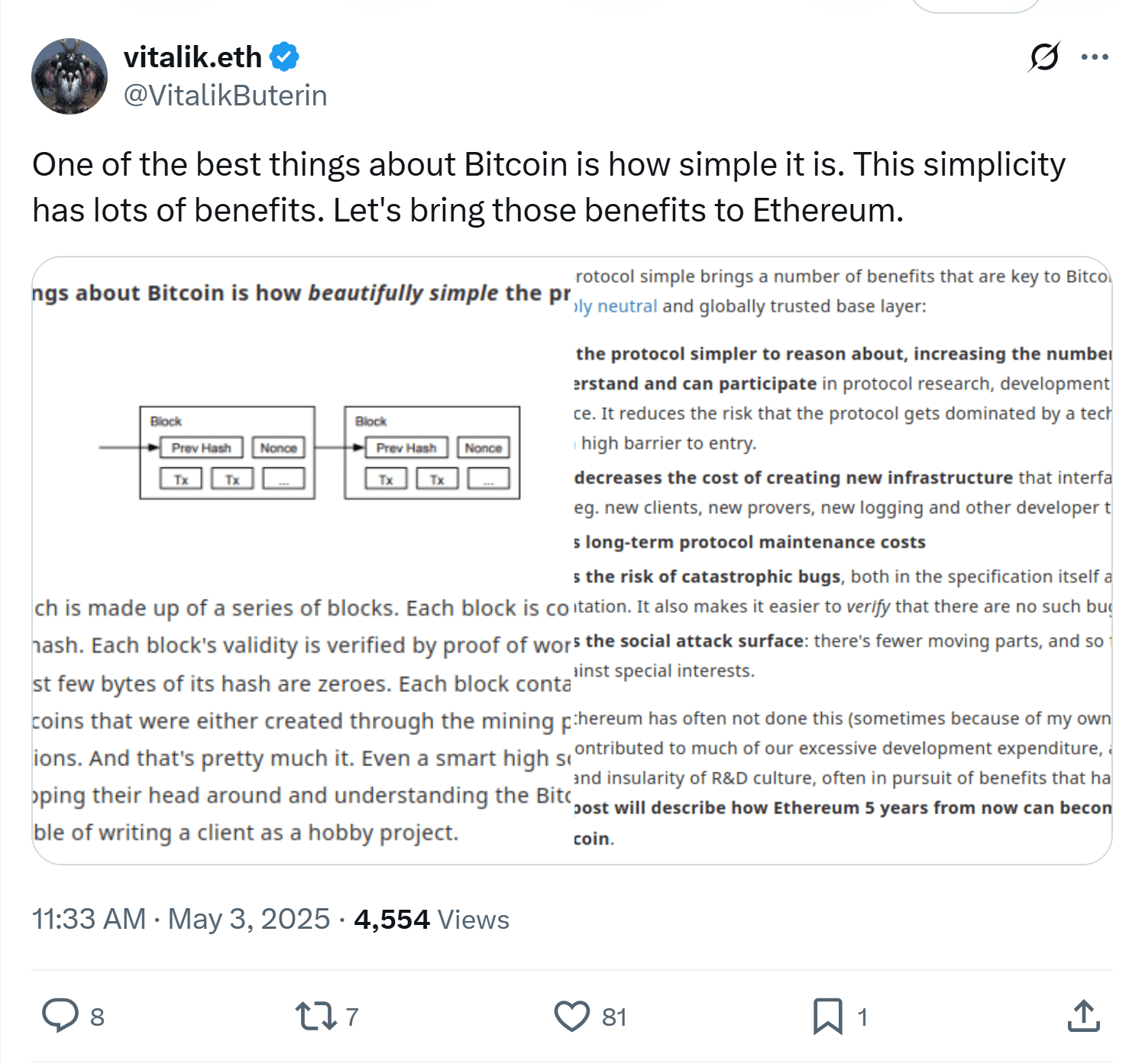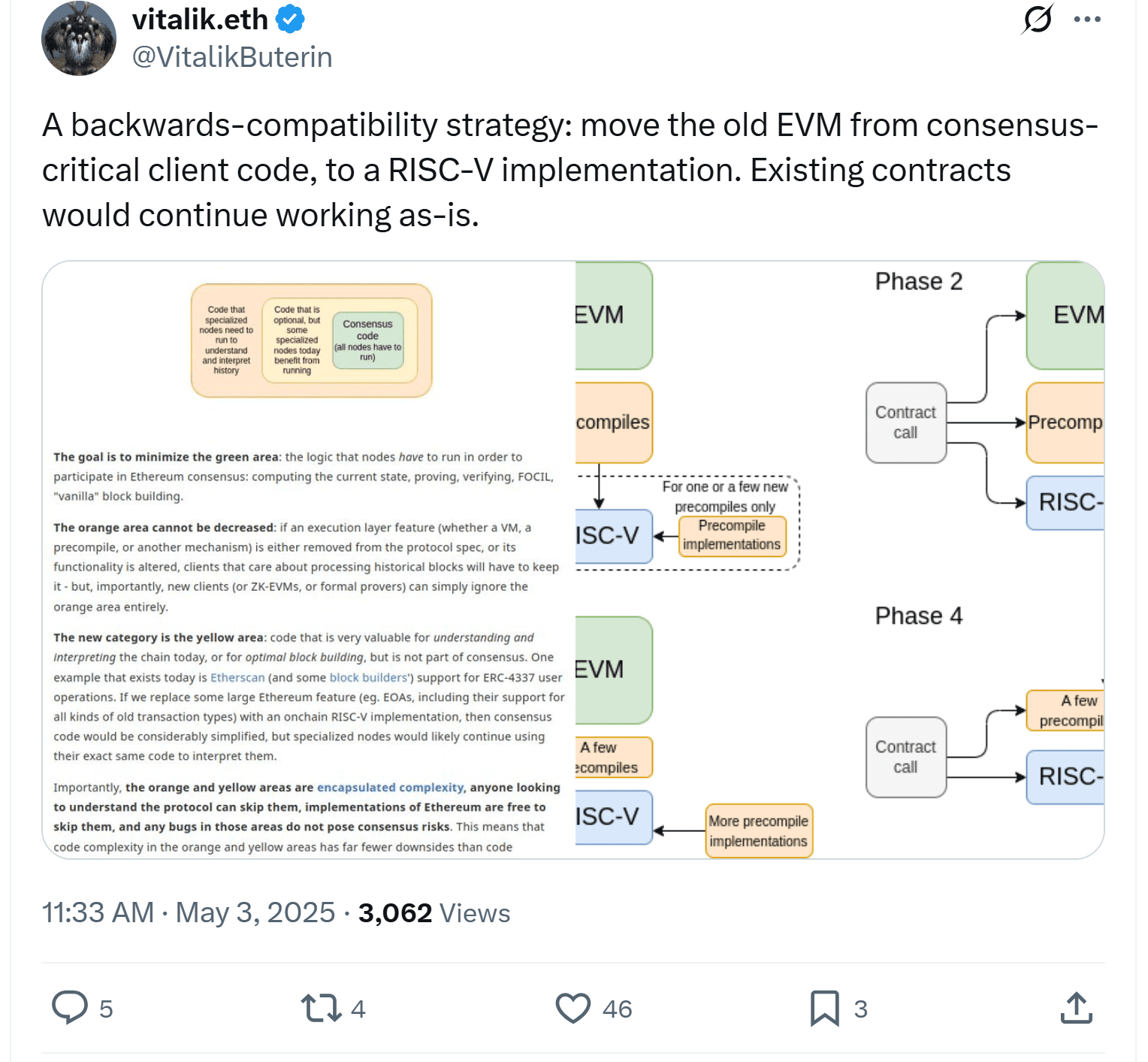Ethereum co-founder Vitalik Buterin has outlined a bold vision to simplify Ethereum’s core protocol, aiming for a design as streamlined as Bitcoin’s within the next five years. This initiative seeks to address the growing complexity of Ethereum, making the network more efficient, secure, and accessible for developers and users alike.
In a blog post titled “Simplifying the L1,” Buterin detailed his plans to restructure Ethereum’s architecture across several key areas: consensus mechanisms, execution environments, and shared components. The ultimate goal is to reduce the burden on developers, minimize security risks, and foster a more inclusive and robust ecosystem.
“This post will describe how Ethereum 5 years from now can become close to as simple as Bitcoin,” Buterin wrote, emphasizing that simplicity is crucial for Ethereum’s long-term resilience and scalability. He argues that while recent upgrades such as Proof-of-Stake (PoS) and Zero-Knowledge Succinct Non-Interactive Argument of Knowledge (zk-SNARK) integration have bolstered Ethereum’s capabilities, they have also introduced considerable complexity.
Buterin acknowledges that this technical complexity has led to longer development cycles, increased costs, and heightened security risks. He points out that excessive complexity can hinder innovation and make the network more vulnerable to bugs and exploits.

Key Proposals for Simplifying Ethereum:
-
3-Slot Finality: Streamlining the consensus layer by implementing a “3-slot finality” model, which eliminates complex elements such as epochs, sync committees, and validator shuffling. This approach reduces the number of active validators, making it safer to use simpler fork choice rules.
-
RISC-V Virtual Machine: Transitioning from the Ethereum Virtual Machine (EVM) to a simpler, ZK-friendly virtual machine like RISC-V. This shift could significantly improve performance for zero-knowledge proofs and simplify the protocol.
RISC-V is an open-source instruction set architecture (ISA) used in designing computer processors. It follows a minimalist design philosophy, using a small set of simple instructions for high efficiency and easier implementation. By adopting RISC-V, Ethereum aims to enhance efficiency and reduce the complexity associated with the EVM.
To ensure backward compatibility, Buterin suggests running legacy EVM contracts onchain via a RISC-V interpreter while supporting both VMs concurrently during a transitional phase. This would allow existing applications to continue functioning seamlessly while the network gradually adopts the new virtual machine.
-
Protocol-Wide Standardization: Implementing uniform standards across the protocol, including a single erasure coding method, serialization format (favoring SSZ), and tree structure. This would reduce redundancy and streamline Ethereum’s tooling and infrastructure.
Buterin emphasizes that simplicity is akin to decentralization, suggesting that Ethereum should adopt a “max line-of-code” target to keep consensus-critical logic as lean and auditable as possible. Non-critical legacy features would remain but reside outside the core specification.

Why Simplify Ethereum?
Buterin’s proposal comes as Ethereum faces increasing competition from other blockchain networks. Alex Svanevik, CEO of data service Nansen, noted that Ethereum’s dominance among Layer 1 (L1) blockchain networks has declined. In a panel discussion at the LONGITUDE by Cointelegraph event on May 2, Svanevik stated that while Ethereum was once poised to dominate the crypto space, it is now clear that this is no longer the case.
Simplifying Ethereum is seen as a way to enhance its competitiveness by improving its scalability, reducing development costs, and making it easier for new developers to build on the platform. By streamlining the core protocol, Ethereum can attract more users and developers, reinforcing its position as a leading blockchain network.
The drive for simplicity reflects a broader trend in the blockchain industry, where projects are increasingly focusing on user-friendliness and developer accessibility. As the industry matures, the ability to create intuitive and efficient systems will be crucial for attracting mainstream adoption.
Potential Benefits of Simplification:
-
Improved Scalability: A simpler protocol can lead to greater scalability, allowing Ethereum to handle more transactions and users.
-
Reduced Development Costs: Simplified codebases reduce the time and resources needed for development, lowering costs for developers.
-
Enhanced Security: Simpler systems are easier to audit and less prone to bugs, leading to improved security.
-
Increased Accessibility: A more straightforward protocol makes it easier for new developers to learn and build on Ethereum, fostering a more vibrant ecosystem.
Vitalik Buterin’s proposal to simplify Ethereum reflects a commitment to long-term sustainability and competitiveness. By drawing inspiration from Bitcoin’s minimalist design, Ethereum aims to create a more efficient, secure, and accessible platform for the future of decentralized applications and finance. The next five years will be critical as Ethereum undergoes these transformative changes, potentially reshaping the landscape of the blockchain industry.